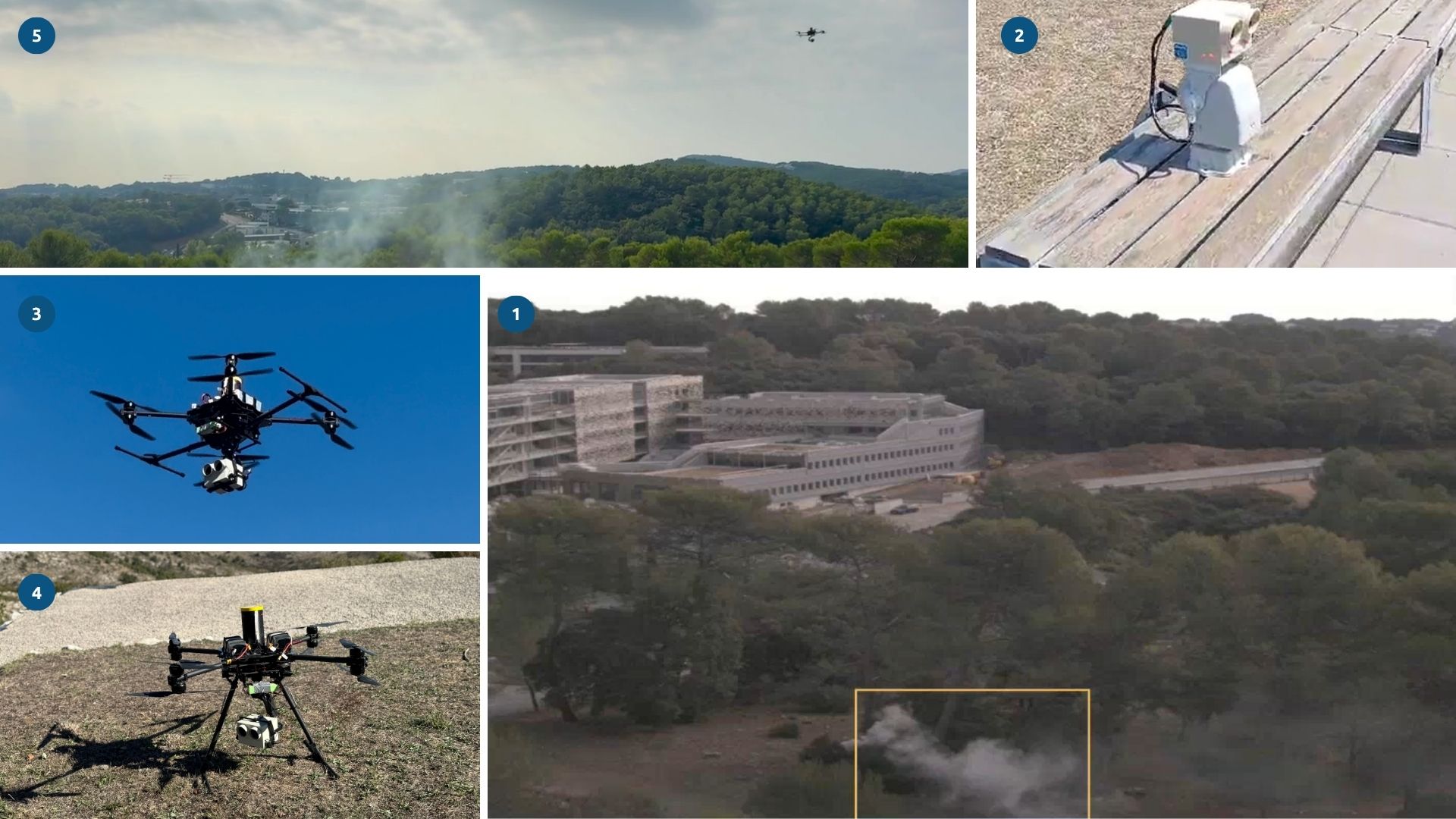Wildfires pose an increasing threat to ecosystems, infrastructure, and public safety. Early detection remains one of the most effective strategies to reduce the impact of these events, yet traditional surveillance systems often suffer from delays, limited coverage, and insufficient situational awareness. The 5G-FIRE project, led by AzurİA in collaboration with EURECOM within the IMAGINE-B5G initiative, aims to address these limitations by integrating advanced 5G connectivity, edge computing, and embedded AI into a single, operational detection system: CamİA.
Enhancing Wildfire Surveillance Through Connectivity
CamİA is a dual-camera (visible and thermal) detection and alert Case that relies on AI to identify early signs of smoke. Initially connected via 4G or Wi-Fi, the system already demonstrated significant operational value. However, emergency services emphasized the need for higher-quality video feeds and remote interaction with the cameras to help confirm alerts before dispatching intervention units.
To overcome these constraints, the 5G-FIRE project upgraded CamİA with 5G standalone (SA) connectivity. This enables:
Low-latency transmission of alert data and HD video,
Remote PTZ control to validate a detection in real time,
Improved reliability in remote or dynamic environments,
Flexible offloading of processing tasks to the edge.
These capabilities are particularly relevant to Public Protection and Disaster Relief (PPDR) operations, where decisions must be made within seconds and often in harsh or isolated environments.
Taking CamİA Into the Air
One key objective of 5G-FIRE was to demonstrate the system’s performance not only on fixed installations but also when mounted on a drone. This integration provides a unique mobile vantage point and extends coverage to previously unreachable areas.
The final demonstration, carried out on 18 October 2025 at the EURECOM Sophia Antipolis campus, served as the culmination of the project’s validation efforts. CamİA was installed on a stabilized gimbal onboard a UAV (Aerovision 06) and connected to EURECOM’s private 5G network operating in FR1 outdoor conditions.
During the demonstration, artificial smoke was generated to simulate an early-stage wildfire event. CamİA autonomously detected the smoke and transmitted :
An alert notification containing the detection snapshot,
A real-time HD video stream enabling operators to assess the situation,
Telemetry providing information about the system’s status.
Simultaneously, operators will be able to remotely control the camera, zooming toward the smoke plume to confirm the detection. This human-in-the-loop approach ensures reliable doubt-removal and avoids unnecessary firefighter mobilization.
Validating Two Detection Pipelines
The final trial also evaluated two complementary AI processing paths:
Onboard inference - Directly on CamİA - Autonomous detection even with reduced connectivity
Edge inference - 5G network edge VM - Offloading compute to reduce UAV payload constraints
The coexistence of these two mechanisms strengthens operational flexibility, allowing the system to adjust to network availability and processing demands.
Performance Outcomes
The field results highlight the benefits of 5G for mission-critical applications:
End-to-end latency: ~21 ms
Uplink throughput: > 37 Mbps during flight
Reliability & Availability: close to 99.9% for alert transmission
Video quality: stable at 30 fps with limited frame drops
These measurements confirm that 5G can sustain the responsiveness and data load required for real-time airborne surveillance.
Beyond performance, the project also emphasized ecological and economic impacts. A Life Cycle Assessment showed that CamİA’s environmental footprint remains low (28kg CO2 for 5 years lifespan), while operational cost savings are anticipated thanks to decreased false alarms and better resource allocation.
Perspectives for PPDR Deployment
The successful final demonstration marks a significant milestone toward the operational adoption of CamİA in PPDR contexts. The outcomes align with the ongoing evolution of European wildfire management strategies, particularly regarding digitalization and increased reliance on autonomous or remotely operated assets.
Public safety stakeholders such as the SDIS, responsible for wildfire surveillance in France, have expressed interest in the solution’s potential for enhancing situational awareness. Future project steps will involve expanding testing to a wider range of operational environments and integrating user feedback into deployment strategies.
Conclusion
The 5G-FIRE project demonstrates how combining onboard AI, reliable 5G communications, and edge processing can significantly improve early wildfire detection and decision support. By enabling rapid confirmation of alerts without exposing personnel to danger, CamİA contributes directly to safer and more efficient firefighting operations.
As wildfire risks continue to rise, we hope that such innovations will play a critical role in strengthening the resilience of communities and ecosystems, helping to stop fires before they spread.
Press release >
Final video (3:30) > Youtube
IMAGINE-B5G #OC3 Projects Webinar (1:13:00) > Youtube
Figure 1. Smoke detected by CamİA, Alert received on the User Interface, during the final test at EURECOM;
Figure 2. Trial 1+2 at EURECOM with the PTZ turret;
Figure 3 & 4. Integration test of CamİA on drone/UAV performed in Vence ;
Figure 5. Final trial at EURECOM, CamİA on UAV overseeing the smoke.
